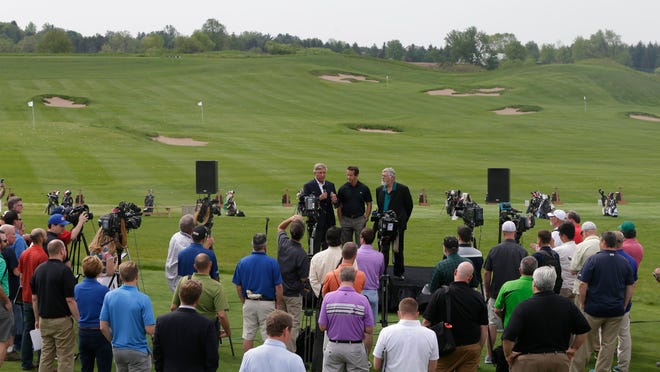D'Amato: Erin Hills is still a mystery as U.S. Open approaches

TOWN OF ERIN – The massive merchandise and media tents are up, the corporate hospitality chalets and bleachers are nearing completion and Erin Hills Golf Course is looking more and more like a U.S. Open venue every day.
The question is whether it will play like a U.S. Open venue when the championship visits Wisconsin for the first time June 15-18.
Will Erin Hills bring the best golfers in the world to their knees, or will the scoreboard bleed red with birdies?
No one knows, and that’s just one of the intriguing story lines of the 117th playing of our national championship. Erin Hills is only 11 years old and other than the 2011 U.S. Amateur has no history of golf at the highest level.
Jeff Hall, the United States Golf Association’s manager of rules and Open championships, said Wednesday at U.S. Open media preview day that the USGA learned a lot about Erin Hills from the Amateur, “but those players don’t have complete Tour-quality refined games day in and day out.”
Erin Hills will be among the longest-ever major championship venues at 7,693 yards and it’s the first par-72 U.S. Open course since 1992. But length without wind means nothing to the best players in the world.
The fairways are going to be wider – in some cases by 50% – than is typical at the Open and the greens are such pure A-4 bent grass surfaces that a lot of putts are going to be holed. There’s none of the 6-inch cabbage rough around the greens and only a couple hazards come into play.
So if rain softens the course and the wind doesn’t blow, how is the USGA going to prevent a birdie-fest?
“If there’s no wind for four days that would be highly unusual but they’ll definitely shoot lower scores,” said USGA executive director Mike Davis. “If it’s softer they’re going to shoot lower scores. The greens are so good they’re going to make putts. And then you’ve got a par 72.
“But listen, at the end of it, contrary to what so many think, we’re not after a certain winning score. What we really are after is to see if we can set the golf course up in such a way that it tests every aspect of the game. As one of our fellow staffers said, we want to see all 14 clubs in a player’s bag get dirty.
“If it’s windy the test is just going to be a little more stern and if it’s not we’re still going to give out the trophy and the Jack Nicklaus gold medal for the low 72-hole score.”
The USGA wouldn’t have awarded the U.S. Open to Erin Hills if Davis, who first saw the land in 2004 – before construction started on the course – thought somebody was going to shoot 22-under par.
The USGA loves the enormity of the 652-acre property and the fact Erin Hills is open to the public. It loves the fact it can control traffic in and out of the course by parking spectators in remote lots and busing them in. It loves the fact the U.S. Open is being played in the Midwest for the first time since 2003.
But if the course didn’t measure up, Erin Hills would never have made it onto the USGA’s radar.
“We really do believe it starts with the great piece of property but it’s the design, the architecture, that really is going to test every skill, every shot-making ability,” Davis said. “And we really do believe that this course is going to identify, hopefully come Sunday of U.S. Open week, a worthy champion.”
Davis’ secret weapon is his ability to manipulate Erin Hills by moving tees, changing angles, putting flagsticks in spots that practically take birdie out of the equation. The course’s flexibility gives him wide latitude to react to the weather and create a stern test.
“Sometimes, you just want them to get up and think, so it’s not the same shot off a teeing ground four days in a row or into the green,” he said. “This course really does offer up that flexibility.”
So pick a score, any score. The winner could finish 2-over par for the week or 12-under. We could see a day on which a handful of players shoot 65s or a day on which only a few break 70.
In four weeks, the mystery will be unraveled.
MORE BY D'AMATO: THE ERIN HILLS SERIES
Coming Sunday
Part 5: Erin Hills finally opens in 2006, but Bob Lang isn’t finished with the course. His passion turns into obsession as he borrows millions to make “enhancements.” Eventually, he runs out of money … and time.
The story so far
Part 1: 'The most perfect site.' How this intoxicating patch of land came to be Erin Hills, site of golf's prestigious U.S. Open next month, is a story filled with drama and conflict, triumph and tragedy. But it started with a small ad in the newspaper.
Part 2: 'You should really give him a call.' Delafield businessman Bob Lang is looking for a piece of land to build a small golf course for his employees and friends. Steve Trattner is looking for a job in golf. Together, they embark on a journey that will transform hundreds of acres in the Kettle Moraine.
Part 3: 'Best piece of golfing property I'd ever seen.' Bob Lang passes on Jack Nicklaus and other big-name course architects to design Erin Hills. Instead, based solely on a gut feel, he hires the relatively unknown trio of Michael Hurdzan, Dana Fry and Ron Whitten.
Part 4: 'It was just craziness, is what I remember.' Years pass without a shovel of dirt being turned and the architects have their doubts that Erin Hills will ever be built. Then Bob Lang attends the 2004 U.S. Open at Shinnecock Hills and everything changes.